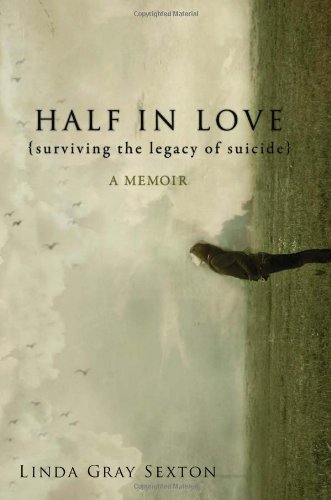 Linda Gray Sexton is the author of Half in Love: Surviving the Legacy of Suicide, as well as Searching for Mercy Street: My Journey Back to My Mother, Anne Sexton.
Linda Gray Sexton is the author of Half in Love: Surviving the Legacy of Suicide, as well as Searching for Mercy Street: My Journey Back to My Mother, Anne Sexton.
Linda is the eldest daughter of Pulitzer Prize-winning poet Anne Sexton. Growing up, Linda witnessed her mother’s struggle with mental illness, including multiple suicide attempts. In 1974, when Linda was just 21 years old, her mother succeeded in taking her own life after appointing Linda to serve as her literary executor. Despite the pain she experienced as a child and young adult as a result of her mother’s condition, Linda also suffered depression, and attempted multiple times to kill herself. However, Linda’s story has a far different ending than her mother’s. Therapy, medicine, and her family’s love and support allowed her to confront and overcome her own issues. Along the way, she learned that there exists a legacy of suicide that is capable of impacting — indeed, consuming — entire families. Linda’s story is one of triumph, survival, and a legacy of life.
The Business of Writing Memoir
Memoir. Such a risky business. You write about your own life, you write about the lives of others, including your family. Some people like what you write, and find it illuminating and courageous that you have dared expose yourself: “to come before us naked,” as the New York Times Book Review said about my latest memoir, Half in Love: Surviving the Legacy of Suicide. Others find it self-congratulatory, or self-referential, or just an outright bid for the limelight.
What happens to your own life when you take a stand in public, when you say that you are a certain sort of person living a certain sort of life? People look for you to be that person, immersed in the life you have portrayed. But if, over time, you find this portrait of yourself to no longer be true, it is an embarrassing—though perhaps necessary—admission, and one that may require going public again. When you write about yourself so frankly, you write about a human being on a journey, a human being in the process of becoming whatever she may be at a certain point in her life. When I wrote my first memoir, Searching for Mercy Street: My Journey Back to My Mother, Anne Sexton, as I turned forty, I asserted that I was very different than my mother, that I could handle my depression, that I would never be suicidal. Then I hit my forty-fifth year, the same year she chose to die by her own hand, just before her forty-fifth birthday.
I was overwhelmed with depression. I could think of nothing except killing myself. I was not handling the legacy of suicide, upon which I had been raised, very well at all. Ultimately, it seemed, I was surprisingly similar to my mother in this regard. What is it like, some people ask me now, to look back and see that you failed at what you had said you would or could do with your life in an earlier memoir?
It hurt to admit that I had come up short in this particular way, to look back and see how easily I had professed that I did not experience the kind of depression my mother did, that I was able to defeat any suicidal urge that troubled me. And it especially hurt that I had said it in public. At first, and in some ways, I felt like a fool on a fool’s errand.

I realized that I was just another person suffering from the disease of bipolar illness and depression, and that I was someone on an important errand after all: to educate people with my story about the nature of suicide, how it is passed down from generation to generation (others in my mother’s immediate family had also killed themselves), about how families struggle to cope with their loved ones who are sick, and how those who are sick struggle to remain alive. In the United States today, someone kills himself every seventeen minutes, and suicide outranks homicide substantially as a cause of death two to one. Over a million people worldwide kill themselves very year. Yes, I tell myself, this is a very important topic on which to speak, no matter how embarrassing.
Recently, the friend of a good friend of mine wrote him an email and said something I found distressing: “It is one thing to come as far as Linda has, but writing about it publicly is quite another. Beyond the obvious risks of being so revealing, there is now public pressure for her to remain healthy and live up to widespread acclaim pointing to her as a ‘poster child’ of recovery and resiliency.” This person’s remark suggests to me that if, when I published Searching for Mercy Street, I had been seen as a public representative for controlling one’s depression and destiny with willpower, with Half in Love I now might be claiming for myself another mantle—a “poster child” for bipolar disorder and suicide, and the recovery from those afflictions. Can I, he asks, live up to the challenge?
When someone raises the specter of the future, of wondering how I will feel about what I’ve written if I “fall off the wagon” of sanity once again, I can only reply that I write what I write because it is true for me at any given time, and that I hope others will find enlightenment in my willingness to expose myself and show what I have learned in my various struggles with life. Half in Love is personal, yes, but it is more than that. It is a way of bringing to public notice the tortured inheritance from which so many suffer and that, for me, makes it all worthwhile.



4 Comments
[New Post] Guest Post: The Business of Writing Memoir https://www.jhsiess.com/2011/01/24/busine…
RT @jhsiess: [New Post] Guest Post: The Business of Writing Memoir https://www.jhsiess.com/2011/01/24/busine…
Such a good point. You are who you are at a particular moment. Fantastic, thought provoking guest post. Thank you!
Pingback: Linda Gray Sexton, author of Half in Love: Surviving the Legacy of Suicide, on tour January/February 2011 | TLC Book Tours